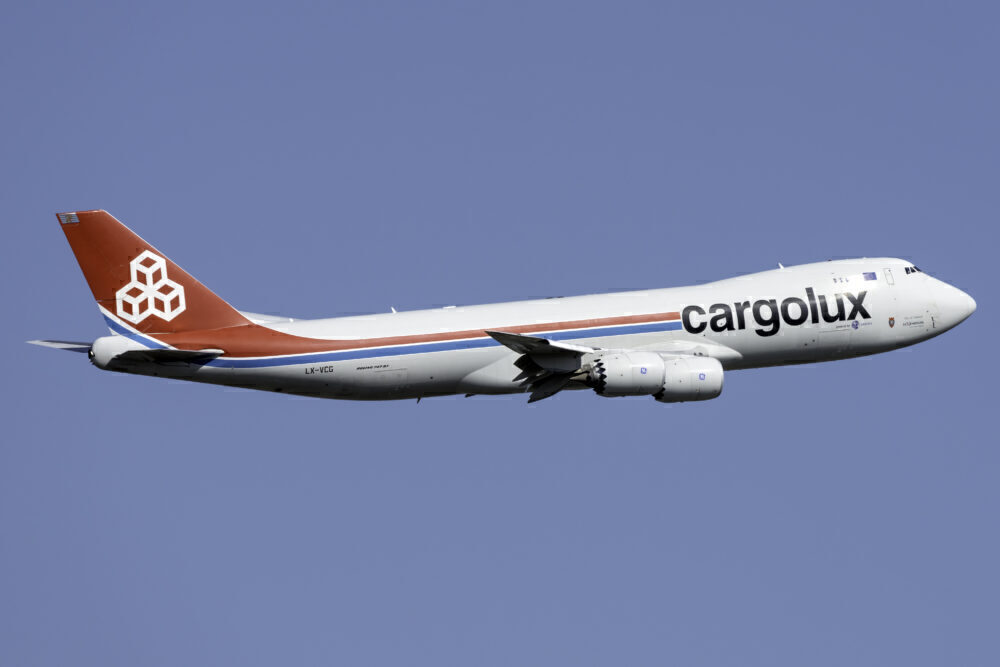The Boeing 747-8 has now been in the air for a decade. The widebody is the final variant of the original jumbo jet to be in production. However, its program is also soon coming to an end. Nonetheless, as the last Queen of the Skies to reign, it holds importance in aviation history.

Covering both angles
In November 2005, Boeing officially launched the 747-8 family. This program would be split between the 747-8 Intercontinental (747-8i) passenger variant and the 747-8 freighter jet.
There were plenty of advancements touted with the aircraft. The 747-8i would be 3.6 m (11.7 ft) longer than the 747-400 to fit in additional seats. It would also have a range of 14,815 km (8,000 NM). However, the key benefits were surrounding the 787-technology GEnx-2B engines. This equipment would enable the aircraft to be quieter, more economical, and more environmentally friendly than the previous 747 variants. Boeing also made sure to express that it would offer 21% lower flight costs than jumbo rival, the Airbus A380.
467 passengers could be served in a three-class configuration, and the plane would feature a new wing design and an enhanced flight deck. Interestingly, it was the first lengthened 747 to be manufactured and the second variant with modified fuselage length after the shortened 747SP.
Boeing was as equally excited about the freighter variant. The plane would be 5.6 m (18.3 ft) more stretched than the 747-400F. Moreover, it would provide 16% more cargo revenue volume than the previous model.
With the announcement of the program, Boeing shared that shipping specialist Cargolux ordered 10 freighters. This airline became the first company to enter the plane into service when it deployed it on February 8th, 2010. Nippon Cargo Airlines also placed orders at the same time as Cargolux.

High expectations
Last month marks a decade since the 747-8I performed its first flight. It took off on March 20th, 2011. Altogether, Boeing emphasizes that the Boeing 747 brings high-value returns on high-volume routes. With a high capacity and space to offer strong first and business class offerings, the manufacturer highlights the maximizing of revenue streams per trip.
Boeing expresses the following on its website:
“The First Class and Business Class sections of the 747-8 enable airlines to offer passengers the most private and premium accommodations in the sky. So it’s no surprise that on high-volume routes the 747-8 offers premium revenue potential. And with more than 400 seats available, this 747 creates a unique opportunity to maximize the bottom-line potential of any high-volume route. It’s premium value, delivered, for operators and passengers. That’s a better way to fly.”
Thus, on June 1st, 2012, Lufthansa flight LH416 left Frankfurt to head to Washington Dulles to inaugurate service with the 747-8i. Christoph Franz, former chairman and CEO of Deutsche Lufthansa AG, was on the flight that day, and he was ecstatic with the launch. Overall, the plane would form an important role in transatlantic operations.
Franz shared the following in a statement.
“The Boeing 747-8 Intercontinental is an exceptional aircraft. With its addition to our fleet, Lufthansa has created a product that is not only in line with our company’s commitment to innovation, technology and efficiency, but that also offers qualities and features that are sure to maximize our passengers’ in-flight experience. Travelers to and from Washington, D.C. are in for a memorable flight and Lufthansa looks forward to expanding our 747-8 Intercontinental service to other U.S. markets in the coming months.”
Notably, Lufthansa has still been flying the type despite universal quadjet phaseouts amid the pandemic. It has been heading east to the likes of Bangkok and Shanghai and east to destinations such as Mexico City, Sao Paulo, and Buenos Aires.

Other orders
Lufthansa was the first airline to order the Intercontinental, having placed 19 orders in December 2006. Only two other commercial carriers joined the flag carrier when it came to this passenger variant. Korean Air ordered 10 units in December 2009 and Air China requested seven in September 2012.
The cargo variant has undoubtedly been far more popular than the 747-8i. With its high loads, firms have been deploying the plane well across the continents.
Other than Cargolux and Nippon Cargo Airlines, Atlas Air, Volga-Dnepr Airlines, Cathay Pacific, Silk Way West Airlines, AirBridgeCargo, and UPS Airlines have all enjoyed shipping success with the type.

95 747-Fs have been delivered over the past 10 years. In contrast, only 45 747-8Is have been taken on by operators. The difference in deliveries between the two models is a result of the fast-changing market conditions. Commercial aviation rapidly steered in another direction during the time when new generation quadjets entered the market. Airlines began to favor more efficient twinjet widebodies. Therefore, the behemoths of the 747 and A380 suffered.
Stay informed: Sign up for our daily and weekly aviation news digests.
A new climate
The 747 family as a whole is being rapidly let go amid the changing situation. The global health crisis is catalyzing retirement parties, and it is becoming increasingly rare to see the Queen in the air.
The type’s program will soon be coming to an end after over five decades. Atlas Air placed an order for another four 747-Fs in January. After these deliveries are made from 2022, there won’t be any more new 747s joining airlines.
Nonetheless, the 747-8 will continue to hold a prominent role in the near future. The aircraft will have the role of becoming the new Air Force One. A pair under development will replace the modified 747-200s that serve the United States president. As an American icon, it’s great to see the 747 continue to serve the country after over half a century since the plane was first launched.
What are your thoughts about the Boeing 747-8 and its operations? What do you make of the aircraft’s journey over the years? Let us know what you think of the jet in the comment section.
from Simple Flying https://ift.tt/2PkvYe0
via IFTTT
Comments
Post a Comment